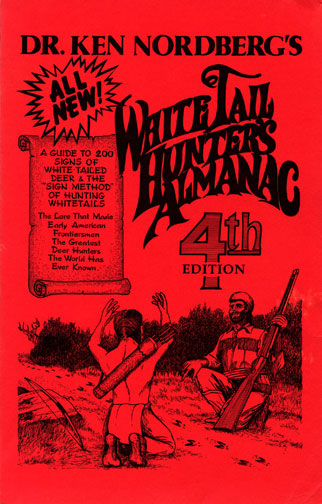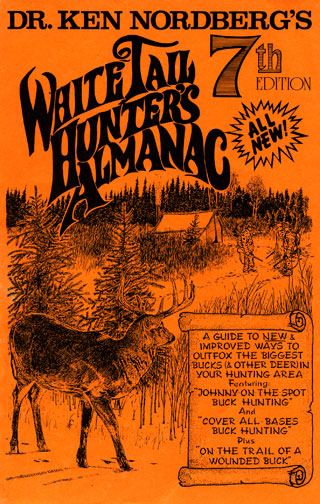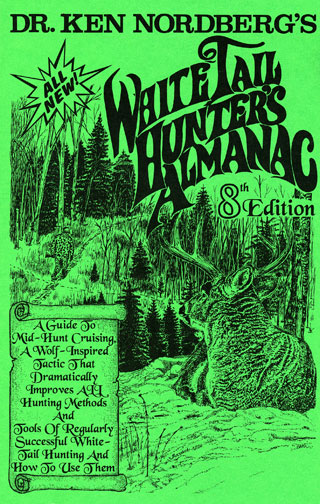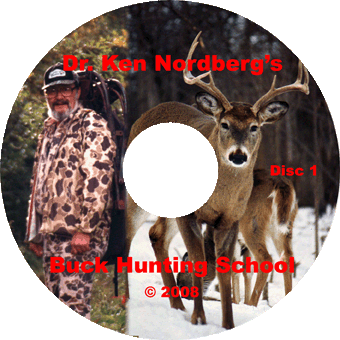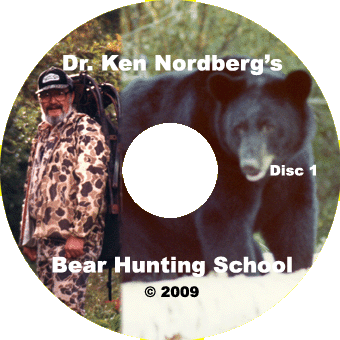Early Rising
By Dr. Ken Nordberg
[The following is the another of many older articles that will appear on my website. This is article was first published in Midwest Outdoors in October of 2006. Please share what you learn from these articles with your whitetail hunting friends.]

Doc with his a nice buck that he shot very early in the morning. (2010, 12-pointer)
Our next opening day (my 61st) will begin about 15 minutes before our deer camp alarm clock is set to ring: at 4 a.m. Mysteriously, that’s when I usually wake up in deer camp. By then the fire in our two-barrel woodstove will have dwindled to a few glowing embers and the temperature inside our big wall tent will be the same as it is outside. Upon arising, I will quickly slip on icy clothing and boots, fumble to light a Coleman lantern, start two fires — one in the woodstove and the other under the coffee pot — and head for the latrine, on the way noting the direction smoke streams from the woodstove chimney. By the time I step back inside, the upper third of the tent will be warm, my hunter partners will be grunting as they pull on various articles of clothing and one will ask, “Which direction is the wind blowing?” Whereas all this is pretty routine to us Nordbergs, the quiet pandemonium of the four o’clock hour in our deer camp is always bewildering to experienced hunters who have been invited to join is for the first time.
“Why are you getting up so early?” we are typically asked. Other common remarks are: “This is crazy;” “You won’t be able to see anything for at least another 2-1/2 hours;” “You’ll get lost;” You’ll chase deer away from your stand sites before you can legally shoot;” “You guys are over-dedicated;” or “You guys are nuts.”
“Well,” I like to respond, “sleep late if you want, but when you hear one or more shots within a mile or so, likely between 6:30 and 7:30, come running because we’ll need your help dragging in one or more big bucks.”
There are good reasons, all learned the hard way, why we get up so early in deer camp.
To begin with, we are buck hunters. We begin each hunting season determined to only take bucks 3-1/2 to 6-1/2 years of age. Having survived three or more hunting seasons, such bucks are well aware of sights, sounds and odors that indicate a season of being hunted by humans is about to begin or has begun. Upon coming to this realization, usually occurring anytime from the day before the opener to the first hours of the opener, they immediately change their habits and behavior. Most notably, whether breeding is in progress or not, they substantially reduce the amount of time they spend moving about — feeding, accompanying does in estrus or traveling from place to place — during daylight hours. At least 85% of the older bucks my partners and I have tagged since 1990 were spotted while heading from feeding areas toward bedding areas between 6:30 (one-half hour before the sunrise) and 7:30 a.m.
Whether accompanying a doe in estrus or not, the bucks we hunt (and most other deer) arrive in feeding areas about two hours before the sunrise. We key on feeding areas. One of the greatest challenges of hunting older bucks is feeding areas is getting close to them in the morning without alerting or alarming them. Unless wind is strong or precipitation is moderate to heavy, it is nearly impossible for any human to get within 100 yards of an adult buck or doe without being heard. Even if the hunter is approaching on a well-cleared stand site approach trail, bucks and most other feeding whitetails will hear the hunter’s footsteps up to 100 yards away; farther on quiet mornings, especially if the hunter is walking in dry leaves or crunchy snow. However, if the hunter’s path is free of twigs and branches that might snap if stepped on or pushed aside, if the hunter makes a conscious effort at bending his or her knees with each step and putting feet (boots) down lightly and if the hunter is well hidden by intervening terrain or cover, any deer that hears the hunter’s footsteps will not be able to positively identify the human. To the deer, the sounds might be made by a potentially dangerous bear, wolf or human or they might be made by a harmless deer, squirrel, fox, bobcat, fisher, martin or mink. An experienced adult buck will certainly be curious about those footsteps for a while and it will thus keep an eye, ear and its nose alert toward the area where it last heard the sounds. If you succeed in reaching your stand sight without being positively identified and then become absolutely silent, the buck (or other deer) will eventually conclude that you either moved stealthily away or you are resting. In either case you certainly are not acting as if hunting and are therefore harmless. Within about 30 minutes, the buck (and other deer within hearing) will resume normal behavior, displaying no fear of the area from which it last heard your footsteps. This does not guarantee the deer will then move toward you, but if your stand site is near its original intended path, the odds are you’ll soon see slowly moving deer.
For the above reasons, we Nordbergs make it a rule to get to our stand sites one-half hour before first light in the morning — about 6 a.m., or one hour before sunrise. We don’t waste a minute on that first and most productive legal shooting hour of the day. Some of us must hike up to two miles before reaching our stand sites. In darkness with the aid of a flashlight, following known, cleared paths, a two-mile hike over rough terrain in the woods generally takes an hour. Necessarily, then, we depart from camp between 5 and 5:30 a.m.
For the above reasons, we clean up deer trails leading to stand sites three or more weeks before the opener [two weeks at the minimum — every year we hear about people scouting the day before the opener, which is one of the biggest mistakes hunters make], making then recognizable in darkness, creating clear (silent) tunnels through cover no more than 30 inches wide and six or more feet tall and never marking them or otherwise making them obvious to other hunters.
For the above reasons, we thoroughly scout and select stand sites (most adjacent to feeding areas) every year, once in early spring before trees grow new leaves (the best time) and once each fall three or more weeks before the opener, making sure our trails are clear and intended quarries are still where we found them earlier.
As previously mentioned (and more thoroughly explained in past articles), adult bucks quickly realize when they are being hunted and therefore make quick changes in habits and behavior to enhance their odds for survival. After the first day or two of hunting season, most things learned about adult bucks while scouting before the opener are no longer useful for stand hunting. For this reason, we also clean up a series of connecting deer trails, creating paths that loop widely through the areas we each hunt. Walking these trails daily, midday, nonstop, we invariably run across very fresh tracks or dropping of adult bucks, indicating where to stand hunt next, that afternoon and the next morning. Each half-day of a hunting season we are thus able to sit (stand hunt) downwind or crosswind of trails or sites currently frequented by adult bucks. [Editorial Note: In numerous other articles and books, Doc has explained why it makes sense to hunt downwind in the morning and crosswind in the evening.]
For the above reasons we generally get to bed by 8 p.m., so we can get up by 4 a.m., fully rested. Sure this schedule is unusual, like nothing we’d willingly adopt at home, but my partners and I never complain. We knows it pays off.
Good Luck Hunting,
Doc


